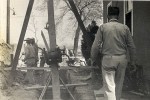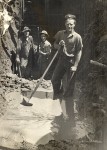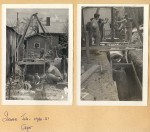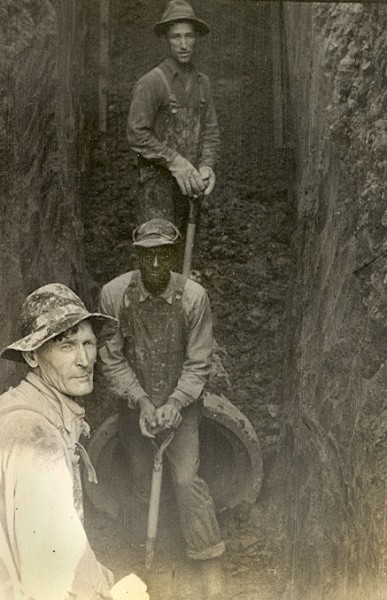 Dad worked for Markham and Brown Construction before he started his own company. These photos are from one of his scrapbooks. They were captioned “Sewer Job – 1940 – 41 Cape.” His sewers aren’t as old as the ones I posted yesterday.
Dad worked for Markham and Brown Construction before he started his own company. These photos are from one of his scrapbooks. They were captioned “Sewer Job – 1940 – 41 Cape.” His sewers aren’t as old as the ones I posted yesterday.
1936 Project required 25 to 100 men
I couldn’t find any news stories about the 1940 project, but E.L. Markham was awarded a $125,837.69 contract to construct a sanitary sewer in the West End in 1936. The February 1, 1936, Missourian story said the project would employ an average of 25 to 100 men for a period of three months. The money was going to come from PWA, one of the alphabet soup of “make-work” agencies created to get men working and pull the country out of the depression. (We’d call that a stimulus project today).
80% of work to be done by machines
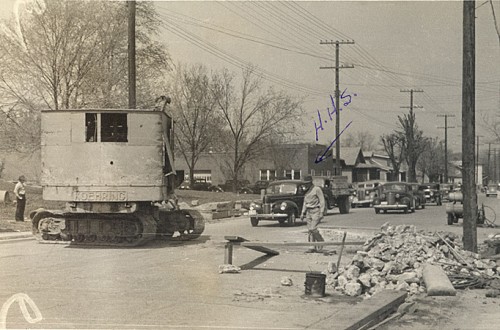 Eighty per cent of the excavation work was to be done by machinery. Laying the sewer pipes would be done by guys like this. About 11 miles of ditches needed to be dug.
Eighty per cent of the excavation work was to be done by machinery. Laying the sewer pipes would be done by guys like this. About 11 miles of ditches needed to be dug.
Dad said a guy came up to him on a job and complained, “Mister, that dragline you’re operating put 20 men with shovels out of work.”
Without missing a beat, Dad responded, “Yep, or 2,000 men with teaspoons.”
The H.H.S. in the above photo would have been my Uncle Hubert Steinhoff. He ended up working for an asphalt company in Illinois.
Skilled labor made 60 to 75 cents per hour
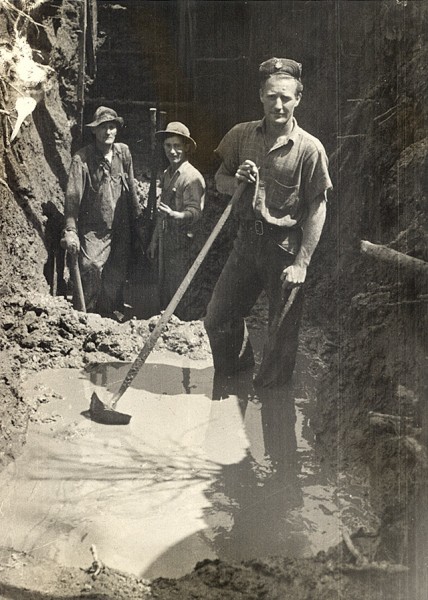 Three classes of labor were to be employed: skilled, semi-skilled or intermediate, and common laborer. Ninety per cent of the workers were to be taken from the relief rolls in the city before looking for other workers.
Three classes of labor were to be employed: skilled, semi-skilled or intermediate, and common laborer. Ninety per cent of the workers were to be taken from the relief rolls in the city before looking for other workers.
Skilled labor, such as operators of machines, concrete finishers and brick layers, were to be paid 60 to 75 cents per hour; intermediate labor, 40 cents, and common labor, 30 cents. Because the goal was to employ as many men as possible, no laborer could be worked more than eight hours a day or 130 hours a month. The PWA preferred that the work day be divided up into two five-hour shifts.
I remember Peewee
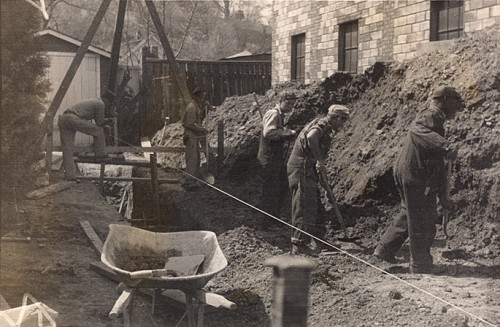 Some of these guys have the fresh-off-the-farm look of some of the fellows I worked with one summer. One young guy named Peewee was built like a fireplug and was strong as an ox. He would make lunch money by betting passersby that he could rip his shirt off just by expanding his chest. As soon as the mark had handed over the ernest money, Peewee would take a big gulp of air and the shirt would go ripping off like The Hulk on the TV show.
Some of these guys have the fresh-off-the-farm look of some of the fellows I worked with one summer. One young guy named Peewee was built like a fireplug and was strong as an ox. He would make lunch money by betting passersby that he could rip his shirt off just by expanding his chest. As soon as the mark had handed over the ernest money, Peewee would take a big gulp of air and the shirt would go ripping off like The Hulk on the TV show.
One day three or four of us were wresting a concrete bucket onto a truck. Peewee walked up, told us to step aside, and threw it on the truck by himself.
Dad was really sorry the day Peewee told him he was going to have to leave the job because he’d been drafted. All that was left was for him to pass his physical. The next day Peewee was back on the job. The army rejected him because he had gotten “all stoved up” when a wagon fell over on him when he was a kid. Maybe that’s why I was a 128-pound weakling: I didn’t have a wagon fall on me during my formative years.
Photo gallery of sewer project
Click on any photo to make it larger, then click on the left or right side of the image to move through the gallery.



